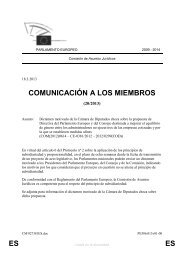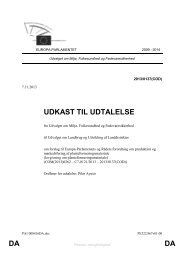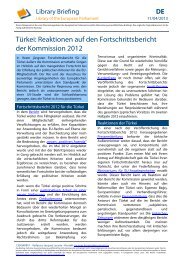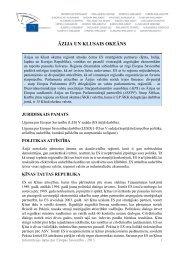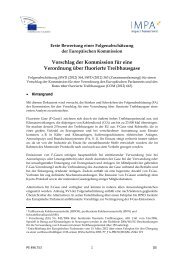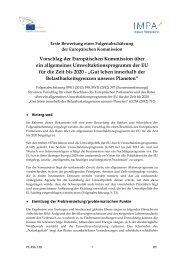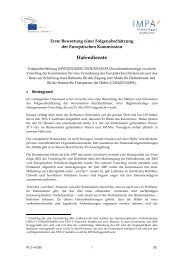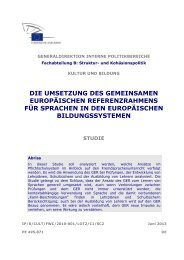Link to the study - European Parliament - Europa
Link to the study - European Parliament - Europa
Link to the study - European Parliament - Europa
Create successful ePaper yourself
Turn your PDF publications into a flip-book with our unique Google optimized e-Paper software.
Policy Department D: Budgetary Affairs<br />
____________________________________________________________________________________________<br />
contaminated in facility-internal smaller or larger release events. Figure 3 shows <strong>the</strong> distribution of<br />
operating times prior <strong>to</strong> entering shutdown state.<br />
Figure 3: Operating time of reac<strong>to</strong>rs before entering shutdown state<br />
35<br />
30<br />
Operating time of reac<strong>to</strong>rs before shut down state<br />
# of reac<strong>to</strong>rs<br />
31<br />
25<br />
20<br />
15<br />
15 15<br />
10<br />
5<br />
6<br />
4<br />
7<br />
10<br />
0<br />
< 5 5..10 10..15 15..20 20..30 30..40 >40<br />
Operating time before shut down (Years)<br />
Source: Authors, data derived from <strong>the</strong> IAEA-PRIS database (PRIS 2013)<br />
The figure shows that one third of <strong>the</strong> reac<strong>to</strong>rs were in operation for between 20 and 30 years,<br />
ano<strong>the</strong>r third for less than 20 years and <strong>the</strong> rest for more than 30 years. So, on <strong>the</strong> one side, <strong>the</strong><br />
current decommissioning projects in <strong>the</strong> EU represent <strong>the</strong> whole range of operating his<strong>to</strong>ry duration.<br />
On <strong>the</strong> o<strong>the</strong>r side <strong>the</strong> majority is not representative of long or very long (beyond 30 years) operating<br />
his<strong>to</strong>ries.<br />
Reac<strong>to</strong>r types of reac<strong>to</strong>rs in shutdown state<br />
Ano<strong>the</strong>r fac<strong>to</strong>r for decommissioning is <strong>the</strong> type of reac<strong>to</strong>r. The reac<strong>to</strong>r types determine <strong>the</strong> technical<br />
modes of deconstruction, <strong>the</strong> waste amounts and types. They indicate specific problematic<br />
deconstruction steps potentially requiring additional R&D. The types differ in terms of <strong>the</strong> modera<strong>to</strong>r<br />
(e.g. water, heavy water or graphite) and <strong>the</strong> coolant used (e.g. water, gas or sodium). The type<br />
distribution in <strong>the</strong> EU is displayed in Figure 4.<br />
34




